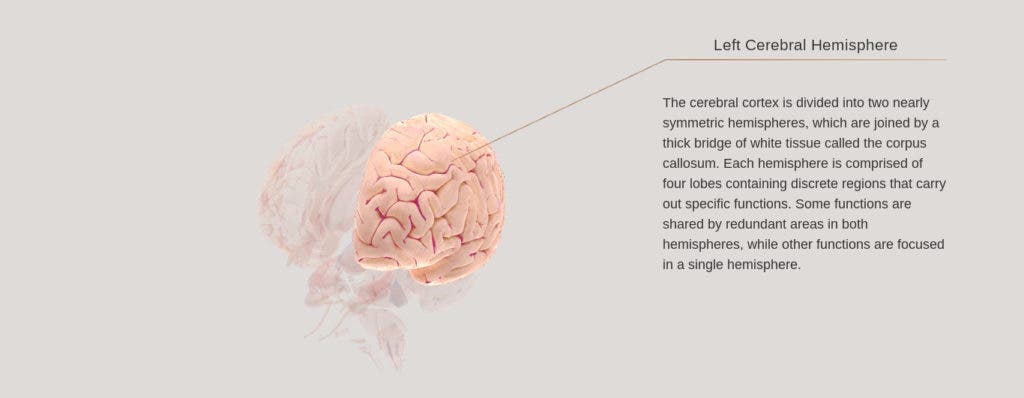Wonderfully resourceful and frighteningly complex, the human brain took us from bashing sticks together in the stone age to a force of geological proportions. Now, you can explore its intricacies in a novel interactive platform dubbed 3D Brain.
Naturally, researchers have been trying to unlock its secrets out for a long time now, and although there’s still more to discover, our understanding of the brain is deeper than ever. Knowledge on its own isn’t much use, however, if it doesn’t work its way into still-functioning brains. With that in mind BrainFacts.org, a “public information initiative of The Kavli Foundation, the Gatsby Charitable Foundation, and the Society for Neuroscience – global nonprofit organizations dedicated to advancing brain research,” has teamed up with the Wellcome Trust, a biomedical research charity based in London, UK, to create a very fun tool named “3D Brain” (link at the bottom of the article.)
It’s the first platform of its kind, devoted to giving anybody with an internet connection, no matter their background, a basic understanding of how our brain works and how it shapes our behavior, wants, and fears. It’s a pretty compelling pitch, one I couldn’t pass on when BrainFacts asked me to take a shot at 3D Brain and see if I like it.
Brain game
“BrainFacts.org is allowing visitors to get inside the brain, teaching us the eight key concepts we all need to know about how the brain works, showcasing a scientifically accurate, interactive 3D model of the brain that reveals internal structures,” says John Morrison, the site’s editor-in-chief.
It all starts with a dialogue-box tutorial — that can finish in literally two clicks — followed by an introductory bit of text next to a floating, 3D model of the human brain. The app looks good but unassuming at first, so much so that, I confess, I’ve skipped the tutorial instructions, relying on my PC-game-trained brain to handle the controls to Brain. Half an hour and a strongly-exercised Wernicke’s area later, I’m still finding out I own bits of brain I hadn’t even thought I needed before (like a Wernicke’s area).
This interactive environment is extremely easy to use. Point and click on anything you’re curious about, click and hold to rotate the whole thing. Any area you’re looking at will be highlighted while the rest of the brain turns transparent so you can have a proper look. On the off-chance that something is still in the way, or if you just want to see how everything fits together, a “structure isolation” bar at the bottom lets you push everything apart. Teachers, professors, or just those of us who love explaining things to others, will be happy to hear that the app also lets you annotate any point across the brain and take snapshots.
I haven’t had any difficulties despite blatantly ignoring the tutorial, though I recommend you go through it if you’re not particularly tech-savvy. The software also runs smoothly, so you won’t have to wait around to switch between areas of the brain.
Brain’s intuitive interface hides a comprehensive look at the brain’s major structures. The 3D model on which Brain relies looks really nice and the app offers enough information to pique your interest without getting overwhelming.
All in all, I really like 3D Brain. More seasoned brain connoisseurs might find the data a bit limited, but I’ve actually learned a lot from it despite only going through about one-third of all the content so far. The 3D model really helps anchor everything you learn to a particular brain area, making it easier to remember later on. Ultimately, poking around the brain and seeing bits and pieces turn transparent or fly away to reveal different structures was really good fun, and that’s a wonderful incentive for learning.
I’ve had a lot of “oh I didn’t know it does that” or “that’s a weird shape” moments toying around with the app, and that seems to be what the people behind it planned all along.
“The experiences we’ve created on BrainFacts.org nurture curiosity and embrace the latest, interactive ways of learning,” says Eric J. Nestler, MD, PhD, and president of the Society for Neuroscience. “By designing these dynamic resources we are better informing the community and engaging students with interactive information about basic and clinical brain research.”
So if you’re looking to spruce up your knowledge of the brain, are looking for an exciting something extra to bring to class, or just want know what a Wernicke’s area is and why you need one, 3D Brain is right down your alley.
[button url=”http://www.brainfacts.org/3d-brain” postid=”” style=”btn-success” size=”btn-lg” target=”_self” fullwidth=”false”]3D Brain[/button]











